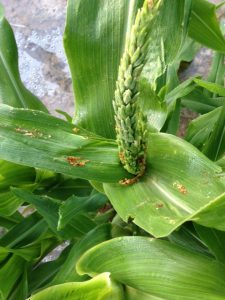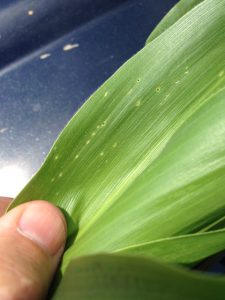Grape and Wine Science Certificate Program will be offered July 22-Aug 16, 2024. This program will provide foundational knowledge in three major areas of grape and wine science – grape growing, wine making, and business operations – following the path of grapes from the field to the winery to the glass. Students will gain competency in all three areas to prepare them for positions in the industry. The program will feature 4 weeks of classroom instruction, complemented by hands-on workshops. Then students will complete a 4-week winery internship where they can put their new knowledge and skills into practice. [Read more…]
Vegetable Crops Edition
Seasonal updates and alerts on insects, diseases, and weeds impacting vegetable crops. New Jersey Commercial Vegetable Production Recommendations updates between annual publication issues are included.
Subscriptions are available via EMAIL and RSS.
Quick Links:
 NJ Commercial Vegetable Production Recommendations
NJ Commercial Vegetable Production Recommendations
 Rutgers Weather Forecasting - Meteorological Information important to commercial agriculture.
Rutgers Weather Forecasting - Meteorological Information important to commercial agriculture.
Phytophthora and Pythium control during wet weather
Most of New Jersey has been wet making current conditions ideal for pathogens such as Phytophthora and Pythium. Unfortunately, Pythium cottony leak and Phytophthora blight can be found on most farms in the southern part of the state. Poor crop rotations with susceptible hosts only make matters worse. The Phytophthora pathogen has an increasing host range that now includes snap and lima beans; and all crops, other than a few resistant bell pepper cultivars, lack any resistance to the pathogen. Under ideal conditions (hot, humid, and wet) Pythium cottony leak can develop on infected fruit.
Vegetable IPM Update 5/22/24
Sweet Corn
A few scattered European corn borer (ECB) moths have been captured in central and northern counties, and this insect is certainly active in southern parts of the state. Numbers are very low, which is consistent with the last few seasons. Whorl corn is the primary target for egg laying, but as yet, scouts have reported no signs of feeding injury in the few plantings that are of suitable maturity. In northern and central counties, corn plantings that were started on/under plastic have reached a size that will support ECB larvae. We expect to encounter some level of feeding over the next 2-3 weeks, although the majority of plantings have not required insecticide treatments for ECB prior to full tassel in the past several years.
 Look for the characteristic “shot-hole” type of feeding (photo below at right) and consider treating when infested plants exceed 12% in a 50 plant sample. As plantings proceed to the pre-tassel stage, ECB larvae may be found in emerging tassels (see photo at left). It is a good idea to treat individual plantings as they move into the full tassel/first silk stage one time. This eliminates any ECB larvae that have emerged with the tassels as they begin to move down the stalk to re-enter near developing ears.
Look for the characteristic “shot-hole” type of feeding (photo below at right) and consider treating when infested plants exceed 12% in a 50 plant sample. As plantings proceed to the pre-tassel stage, ECB larvae may be found in emerging tassels (see photo at left). It is a good idea to treat individual plantings as they move into the full tassel/first silk stage one time. This eliminates any ECB larvae that have emerged with the tassels as they begin to move down the stalk to re-enter near developing ears.
Useful insecticides for this particular application include synthetic  pyrethroids (IRAC Grp 3), spinosyns (including OMRI approved Entrust) IRAC Grp 5), and diamides such as Coragen or Vantacor (IRAC Grp 28) or materials such as Besiege which include the active ingredient in Coragen. Synthetic pyrethroids alone should NOT be used for corn earworm (CEW) protection on silking corn. Control with these materials is very inconsistent.
pyrethroids (IRAC Grp 3), spinosyns (including OMRI approved Entrust) IRAC Grp 5), and diamides such as Coragen or Vantacor (IRAC Grp 28) or materials such as Besiege which include the active ingredient in Coragen. Synthetic pyrethroids alone should NOT be used for corn earworm (CEW) protection on silking corn. Control with these materials is very inconsistent.
The highest nightly trap catches* of ECB for the week ending 5/22/24 are as follows:
| Asbury 1 | Georgetown 1 |
| Califon 1 | Sergeantsville 1 |
| Farmingdale 1 | South Branch 1 |
* No blacklight traps are in operation south of the Columbus (Burlington Co.) area this season.
Understanding and controlling angular leaf spot in strawberries
Often considered a minor pathogen, angular leaf spot caused by the bacterium, Xanthomonas fragariae, can cause serious leaf and calyx infections ruining the marketability of fruit if left uncontrolled. [Read more…]
Identifying and controlling common leaf spot in strawberry
Strawberry leaf spot, caused by the soil-borne fungal pathogen, Mycosphaerella fragariae, can infect leaves, petioles, runners, fruit stalks (pedicels), and berry caps or calyxes. Small, dark purple to reddish-purple, round spots, 1/8 to 1/4 inch in diameter (3 to 6 millimeters), appear on the upper leaf surfaces. The center of the spots soon become tan or gray and eventually almost white, while the broad margins remain dark purple. Later in the season, dark specks (sclerotia and/or perithecia) may be seen in the older lesions. Tannish areas form on the undersides of infected leaves. The symptoms on the other plant parts, except the fruit, are almost identical to those that develop on the upper leaf surface. [Read more…]
NEWA Disease and Insect Forecasting System
Since 2011 the vegetable working group has teamed up with Cornell University’s NEWA to bring tomato and potato late blight and early blight forecasting to vegetable growers throughout New Jersey. Over 50 weather stations from Sussex to Cape May County now offer disease as well as insect forecasting services for numerous important pests. [Read more…]
